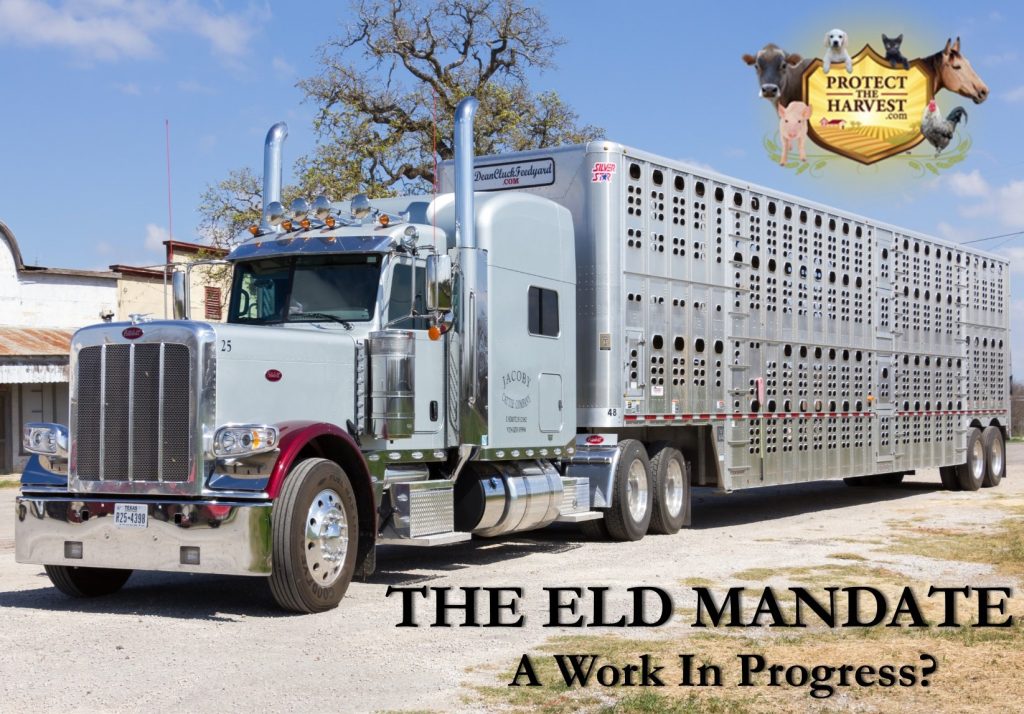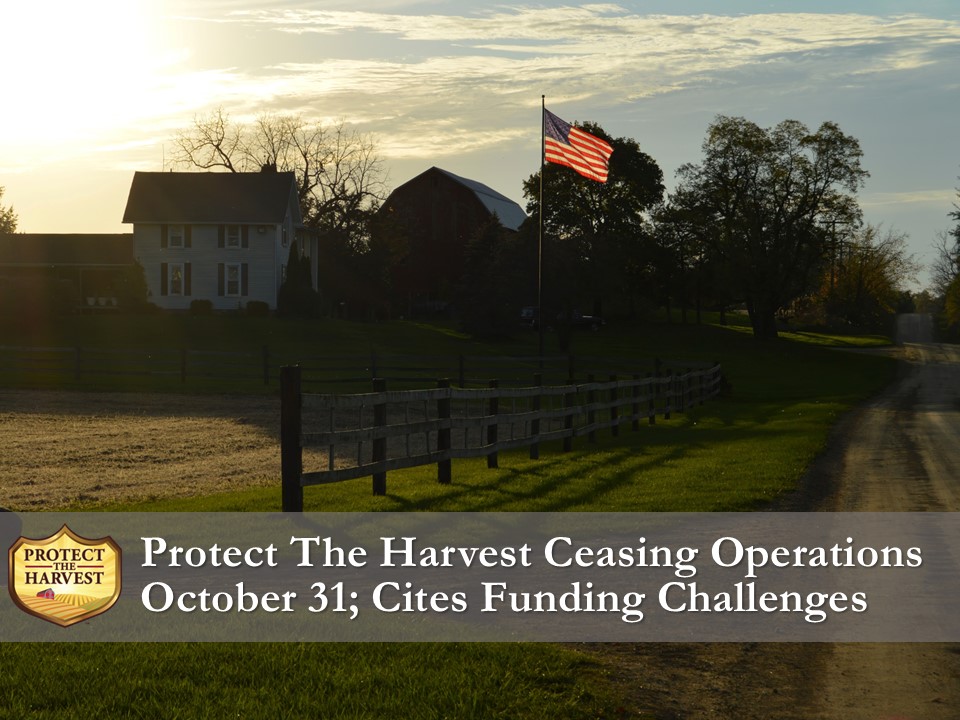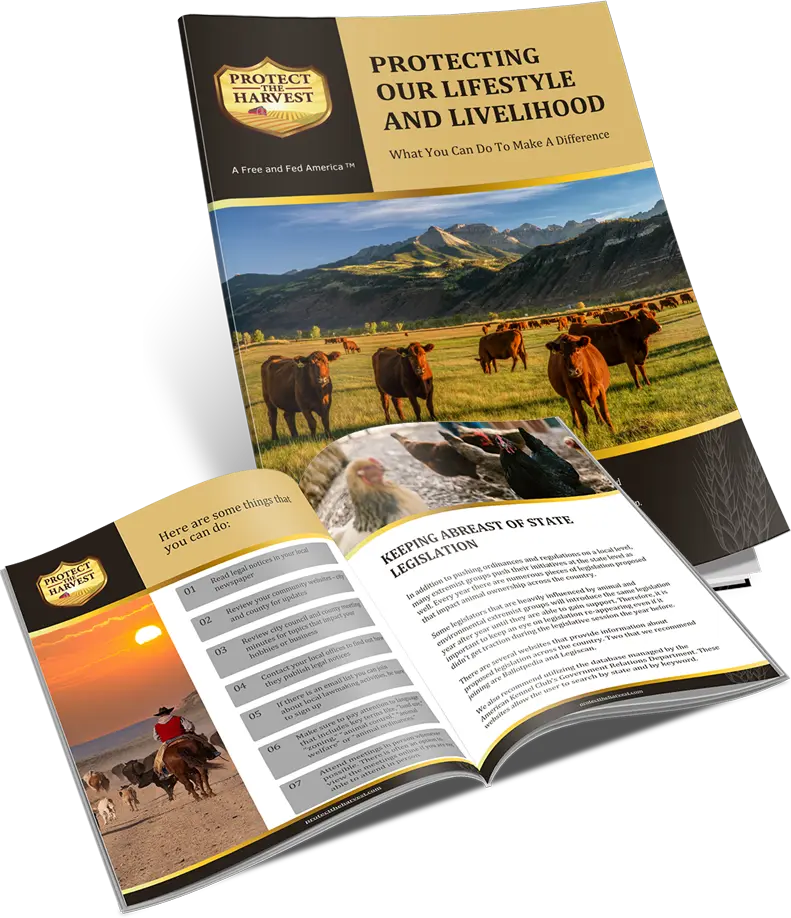THE ELD MANDATE – A WORK IN PROGRESS?
Until the Fall of 2017, most people outside of the commercial trucking industry had never heard of the ELD Mandate. It quickly became a hot topic as agriculture and transportation groups (including Protect The Harvest) started educating the public on some of the unforeseen issues with its implementation and enforcement.
With the recent reintroduction of several bills in both the House and Senate, it seems an appropriate time for an update and review.
Where did the ELD Mandate Come From:
The Electronic Logging Device (ELD) Mandate was instituted as part of Moving Ahead for Progress in the 21st Century (MAP-21) signed by President Obama in July 2012. The ELD automatically records a driver’s driving time and other aspects of the hours-of-service (HOS) records. With an ELD, a driver must operate under a very strict schedule of drive time and time when they are out of service.
Safety Was Not Improved
MAP 21’s proposed purpose is to help the Federal Motor Carrier Safety Administration (FMCSA) reduce crashes, injuries and fatalities involving large trucks and buses. A recent study published on researchgate.net combined detailed data from millions of driver inspections and all federally recordable crashes from January 1st, 2017 through September 1st, 2018 to assess the effectiveness of the mandate.
General findings reported:
• Percentage of HOS violations declined.
• No statistically significant evidence that ELD adoption by the smaller firms corresponded to any reduction in accident rates.
• Unsafe driving violations by owner operators increased.
Full study including citations from other safety studies. https://www.researchgate.net/publication/330425892_Did_the_Electronic_Logging_Device_Mandate_Reduce_Accidents
One Size Fits All Doesn’t Work
In addition to the lack of improvement in safety records, these devices are designed to be one size fits all with no room for variance. Commercial haulers and their wide variety of cargo are far from a one size fits all group. They also have many aspects outside their personal control, including but not limited to, weather, traffic, loading/unloading delays, breakdowns, and much more; none of which are considered by the ELD. For many reasons the ELD and its strict schedule for HOS and the heavy fines for recorded offenses does not work for the majority of commercial haulers.
Consider all those variables, now add live animals as the cargo. The Hours of Service rules including a mandatory 10 hours off duty after 11 hours of driving causes serious animal welfare concerns.
Commercial Livestock & Bee Hauling:
The primary concern for anyone hauling livestock is getting from point A to point B safely with as little stress and travel time as possible for the animals. Commercial livestock haulers are experts in their field. Not only do they have some of the best safety records but are also knowledgeable stockman. Livestock haulers account for less than 1% of the tractor trailer involved accidents.
Livestock trailers have been designed with the animals’ comfort in mind. They have vents allowing for air flow and special air ride suspensions to help keep the ride smooth and allow for their shifting weight. A driver being forced to stop for 10 hours makes no allowances for the needs of the animals in their care. Below are just a few of the problems the ELD Mandate and Hours of Service pose to livestock haulers:
The 10 hours out of service would cause a need to unload and reload the animals mid-trip.
- There is not an existing infrastructure of facilities to handle the unloading, lay over care, and reloading of livestock onto trucks.
- Bio-security would be at risk. Cross contamination and spread of disease could happen easily and be hard to trace back to a source.
- Loading and unloading, no matter how much expertise someone has, adds stress to the animals.
The ELD mandate and its strict HOS rules do not allow for the safe transportation of livestock.
Bees
Bees pollinate 70% of the food crops for animals and human consumption in this country. Many farming areas don’t have an existing bee population large enough to get the pollinating job done. Obviously, the ability to move bees around the country is paramount in keeping our growing U.S. population fed. Traveling bees offer what’s called “saturation pollination”, this process helps farmers maximize their yields while making the most efficient use of their land, water and other resources, helping to keep food prices low.
To get bees safely from coast to coast takes a special kind of hauler. Bee haulers are a highly skilled group. In addition to their truck driving knowledge, they are also experienced bee keepers. Bee are very sensitive to heat; steady air flow is important to keeping them inside their hives during transport. If they leave their hives while on the truck, they are at risk of being killed or escaping the specially designed netting. The ELD mandate with its strict HOS rules does not allow for the safe transportation of bees.
Article about Risks to Animal Welfare: http://protecttheharvest.com/news/giant-step-back-animal-welfare-eld-mandate/
Article about Bee Hauling: http://protecttheharvest.com/news/eld-mandate-food-supply/
Thankfully, as a result of countless hours of hard work from groups negatively affected by ELD enforcement and the education of both lawmakers and those at FMCSA, transporters of livestock and insects are not currently required to have an ELD. The statutory exemption will remain in place until further notice. Drivers do not need to carry any documentation regarding this exemption.
List of Concerned Groups and Lawmakers: http://protecttheharvest.com/initiatives/eld-mandate/concerned-groups-and-individuals/
This statutory exemption allows for some much needed time to try and work toward a permanent solution for commercial agriculture haulers and others affected by related laws.
Below is a review of some proposed legislation to address the ELD Mandate and Hours of Service Issues:
Modernizing Agricultural Transportation Act
Senators John Hoeven (R – ND) and Michael Benner (D – CO) reintroduced the Modernizing Agricultural Transportation Act on February 28, 2019. This bill offers regulatory reform with the goal to give livestock haulers a permanent solution to the Hours of Service (HOS) and Electronic Logging Device (ELD) rules. It provides the needed flexibility while ensuring road safety and humane transportation of animals.
Originally introduced in June 2018, this bill would form a working group comprised of representatives from the transportation and agriculture industries, transportation safety representatives and the U.S. Department of Agriculture. The working group would identify obstacles to the safe, humane and market-efficient transport of agricultural commodities, including livestock, and within one year of the group’s establishment, develop guidelines for regulatory or legislative action to improve the transportation of these commodities.
This bill has the support of several agriculture organizations like the United States Cattleman’s Association, National Pork Producers Council, American Honey Producers Association, Livestock Marketing Association, American Farm Bureau Federation, National Association of State Departments of Agriculture, Rocky Mountain Farmers Union, National Cattlemen’s Beef Association and North Dakota Stockmen’s Association.
Two Bills reintroduced in the House on March 12, 2019
On March 12th, 2019 Representatives Collin Peterson (D – MN-7) and Congressman Greg Gianforte (R-MT) reintroduced 2 House bills. H.R. 1698 Agricultural Business Electronic Logging Device Exemption Act designed to exempt certain motor carriers engaged in agricultural business from the ELD requirements, and for other purposes. The other is H.R. 1697 Small Carrier Electronic Logging Device Exemption Act. This bill aims to exempt motor carriers that own or operate 10 or fewer commercial vehicles from the electronic logging device mandates, and for other purposes.
Many organizations have expressed support of 1 or both bills. Included are Minnesota Farm Bureau, Minnesota State Cattlemen’s Association, United States Cattlemen’s Association, American Sheep Industry Association, TruckerNation, Western Equipment Dealers Association, and United States Transportation Alliance.
Transporting Livestock Across America Safely Act – TLAAS (H.R.487)
Transporting Livestock Across America Safely Act was reintroduced January 10, 2019 in the House by Rep. Ted Yoho (R-FL-3) and currently has 32 co-sponsors. Representative Yoho introduced this bill originally in June of 2018.
TLAAS requires the Department of Transportation to amend regulations for Hours of Service (HOS) for commercial livestock and insect drivers. It would expand the 150 air-mile radius to 300 before on-duty time begins. The regulations would exclude certain activities, such as loading or unloading from their on-duty time and increase the allowed driving time from 11 to not less than 15, and not more than 18 hours within a 24-hour period. Drivers would be permitted to take one or more rest periods during their drive time that are not included in their HOS. After the completion of the trip, the driver would have a mandatory rest break for a period that is five hours less than the maximum driving time.
A companion bill introduced in the Senate by Senator Ben Sasse (R-NE) on 5/23/2018, as of yet, it has not been reintroduced.
The goal of these bills and any others that may be in the pipeline is to ensure the roads stay safe, while still allowing drivers the flexibility to ensure the animals’ and insects’ welfare is not compromised in the meantime.
In addition to the introduction of bills, the FMCSA extended comment periods to allow industry stakeholders to voice their concerns. FMCSA administrator, Raymond Martinez, said as he addressed the 81st Annual Truckload Carriers Association in early March 2019, “[The ELD mandate] really put a spotlight on something that hasn’t been looked at in over 15 years. The data generated by ELDs highlights areas of current HOS regulations where adjustments or improvements may be needed. Commerce has changed, technology has changed, and your business has changed in that time.”
The Entire Commercial Trucking Industry is Affected
ELD compliance puts pressure on all commercial drivers, not just haulers of livestock and insects. As mentioned earlier in this article, there is evidence that the ELD Mandate does not improve accident rates. According to TruckerNation, nearly 70% of all products consumed in the U.S. are transported by a commercial vehicle and industry estimates a driver shortage of at least 50,000. As regulations and restrictions are increasingly levied on truck drivers, it is reasonably estimated that more drivers will continue to leave the commercial transportation industry. When the ELD Mandate went into effect some of the more experienced drivers opted to retire from trucking altogether or change careers due to the over-regulation.
As consumers, this means higher prices and longer wait times for those goods.
Exemptions Prove the ELD Mandate is Flawed
When the mandate was originally passed, a few exemptions were included for older trucks, short haul drivers, or drivers that only need the keep records of service for 8 days in any 30-day period. In addition to those exemptions, many companies and industries have filed for and received exemptions from the ELD Mandate. The number of exemptions and the variety of different recipients helps show that the entire mandate needs to go back to the drawing board.
Farmers, Ranchers, and Other Not For Hire Drivers
Even though Commercial Motor Vehicle (CMV) laws were written to govern the commercial trucking industry, many private drivers have now been caught up in the tangle of confusing and restrictive regulations. The ELD Mandate enforcement brought to light some unforeseen consequences many were not aware of until now.
Commercial License Ratings Have Not Kept Up With Technology
The safely and reliability of vehicles has improved greatly since 1986, the last time commercial vehicle regulations and licensing requirements were updated. There is a dire need to modernize the regulations. Gross Vehicle Weight Ratings (GVWRs) of 1-ton pickup trucks have increased 65% since 1986. Vehicles have better drive trains, stronger and more efficient engines, and increased stability with more sophisticated breaking systems.This makes modern pickup trucks capable of safely hauling larger loads and trailers. Since this is the case, why are grossly out of date weight thresholds from the Commercial Motor Vehicle Act of 1986 still in effect? The weights chosen to require a Commercial Driver License in 1986 once excluded the millions of farmers, ranchers and horse enthusiasts driving pickup trucks hauling their own property in gooseneck trailers.
Now, many of the formally excluded, are included simply due to safety improvements auto manufacturers have built into their vehicles. This means a newer pickup truck, pulling the same trailer as an older pickup, may trigger the need for a CDL, despite the fact that the driver is now more safe hauling that trailer with the newer pickup truck. Millions of drivers are impacted by the unintended consequences of these archaic GVWR thresholds.
On the federal level, the FMCSA has given the following not-for-hire groups exemptions.
FMCSA exemptions for non-commercial horse haulers and agriculture commodities
Non-commercial hauling for horses
February 22, 2018 – The Federal Motor Carrier Safety Administration (FMCSA) provided guidance for non-business-related transportation of horses, including transportation to horse shows or other events. To qualify for this exemption, there can be no compensation for the transportation, and the driver cannot be engaged in business related to the transportation (i.e., a professional operation or trainer transporting horses).
This non-business-related transportation, even if prize or scholarship money is offered has exemptions including HOS regulations, requirements for Electronic Logging Devices (ELDs) and Commercial Driver’s License (CDL) regulations, unless a CDL is required by the driver’s home state.
Covered Farm Vehicles
Farmers and ranchers also have some federal exemptions written into MAP 21, though hindered by the weight thresholds from 1986. Covered Farm Vehicles (CFV) defined as a vehicle operated by the owner or operator of a farm or ranch, or a family member or employee of the owner or operator that is used to transport agricultural goods. Covered farm vehicles weighing 26,001 pounds or more, operated by a farmer or a farmer’s employee, are exempt from HOS and CDL regulations if the vehicle is operated in the state of registration or within a 150 air-mile radius of the farmer’s farm or ranch. Covered Farm Vehicles weighing 26,000 pounds or less are exempt throughout the country. This exemption does offer some relief for farmers and ranchers that haul their own goods. However, especially in the rural areas of the western U.S., the 150 air-mile radius falls short of getting many to a competitive market. Centralization and modernization have spread these markets apart. Every other grain elevator is often owned by the same cooperative. Some cattle sale barns are more competitive than others. An expansion to the CFV air-mile radius is just as important to farmers and ranchers as it is for commercial agriculture haulers.
State Regulations
Though federally exempt, these groups still have state level laws to consider. Depending on the state of residence, many have slightly different laws regarding exemptions, GVWR thresholds, agriculture, CFV air-mile radiuses, and required driver’s licenses. It is very important that every driver understand the laws in their home state to ensure they are legal for what they own and drive.
A person can only have a driver’s license in one state at a time, if someone is legal in their state of residence, they are legal to drive in the other states. Though most state’s laws are in the same ball park as the federal laws, some states, like California, have extremely strict state level laws for private and recreational livestock haulers.
Thank You and Please Help Educate
Protect The Harvest as well as Lucas Oil have been working hard for nearly 3 years to bring the ELD Mandate, Commercial Driver’s License and Hours of Service issues to the attention of both the public and lawmakers. In addition to sharing information, we have made trips to Washington DC to meet with lawmakers to help find a resolution. There are several other groups that are also very involved. As we continue to work to help the groups we mentioned in this article, consider calling and writing your lawmakers, educate them as needed, and ask them to support reforming the ELD Mandate and updating other related laws.
Please share this information and encourage others to do so as well.



